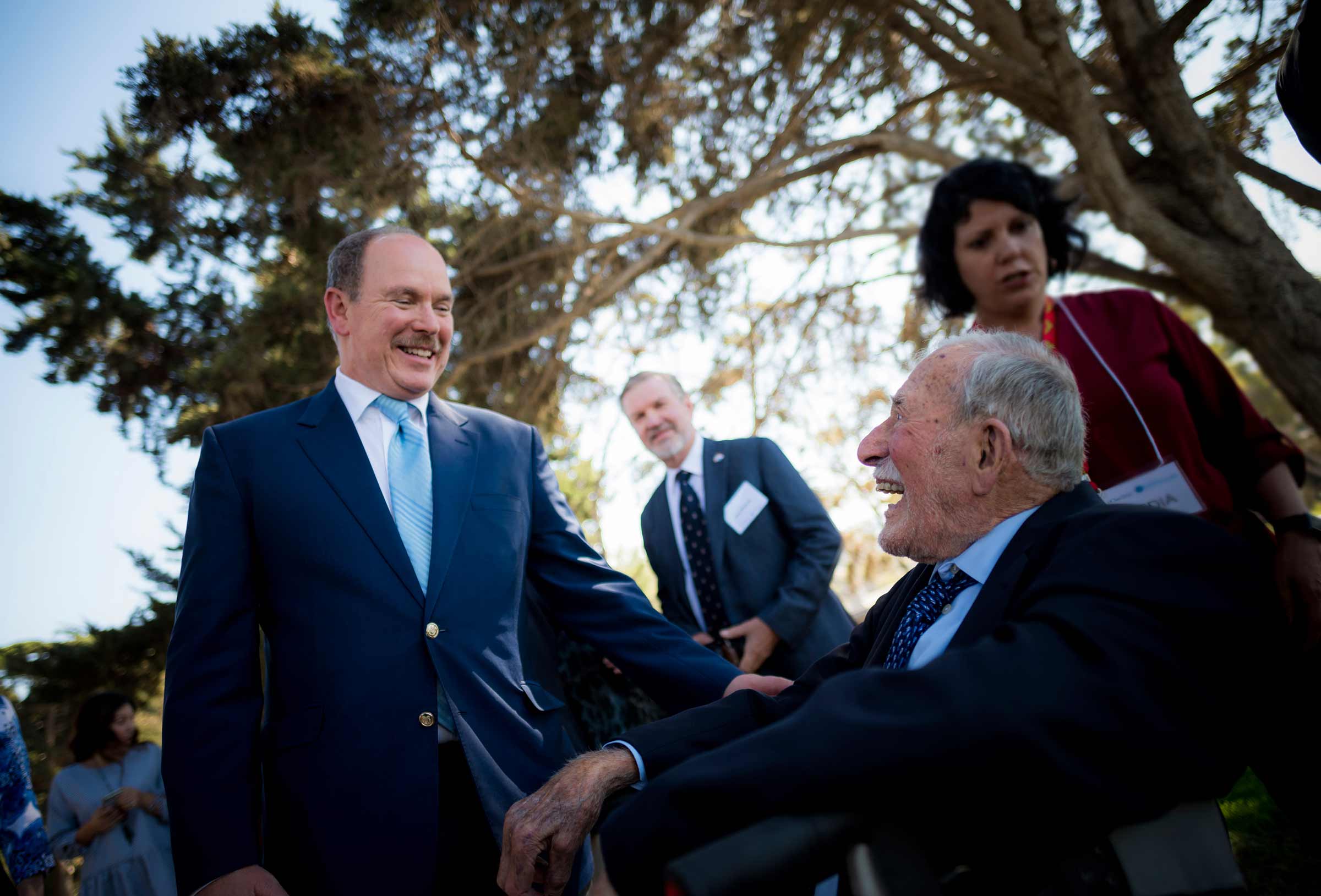
By:
- Lauren Fimbres Wood
Published Date
By:
- Lauren Fimbres Wood
Share This:
A Royal Celebration
His Serene Highness Prince Albert II helps Walter Munk celebrate his 100th birthday during special visit

His Serene Highness Prince Albert II greets Walter Munk upon arriving at Scripps Institution of Oceanography at UC San Diego. Photos by Erik Jepsen/UC San Diego Publications
UC San Diego’s oldest living alumnus, Walter Munk, capped a weeklong celebration of his 100th birthday with an event fit for a prince. His Serene Highness (H.S.H.) Prince Albert II of Monaco returned to UC San Diego on Oct. 26 to join the renowned oceanographer in a Centennial Conversation where the two discussed their shared passion for ocean exploration, the importance of investing in scientific research, and hope for collaborating to solve climate change in the future.

The birthday cake for Walter Munk featured an image of the Mobula munkiana, the Munk’s Devil Ray named after him.
In front of a packed house at the Robert Paine Scripps Forum for Science, Society and the Environment at Scripps Institution of Oceanography, and livestreamed online, the talk followed a busy week for Munk. On Oct 18, the City of San Diego officially named the La Jolla Shores boardwalk “Walter Munk Way,” and on Oct. 19, Munk celebrated his 100th birthday with a handful of public and private celebrations.
Munk joined Scripps Oceanography in 1939 and has been called the “Einstein of the oceans” and the “father of the surf forecast.” He is known for inventing the science of wave forecasting with former Scripps director Harald Sverdrup, which helped Allied troops plan amphibious invasions during World War II. Munk also pioneered tide prediction, and many aspects of ocean acoustics, ocean circulation, and deep-sea tides.
An advocate for seafaring science and working in the field, Munk regaled the crowd with stories from his most memorable moments. This included a story about his famous Heard Island experiment, where Munk tested if ocean sounds transmitted from the Southern Indian Ocean could be heard around the world.
“I thought it would be great fun to see whether you can send a signal halfway around the world,” said Munk. After receiving an urgent telegraph message that the preliminary test had worked, he said, “I can't tell you how exciting that was.”
The Principality of Monaco became involved with ocean conservation with Prince Albert I, who financed four vessels used for oceanographic expeditions and took part in more than 20 oceanographic expeditions at the end of 19th century and beginning of 20th century. In 1910, he created the Oceanographic Institute in Paris and the Oceanographic Museum in Monaco.

Vice Chancellor for Marine Sciences, Margaret Leinen, served as the moderator for the discussion between Munk and H.S.H. Prince Albert II.
Prince Albert II has followed in the footsteps of his great-great grandfather by creating the Prince Albert II of Monaco Foundation, dedicated to preserving the environment and promoting sustainable development. H.S.H. Prince Albert II has a passion for scientific expeditions and is the only head of state to have visited both the North Pole and the South Pole.
“You have to not only feel, breathe the air, and see things first hand but you have to talk to the people who are there in the Arctic and the indigenous populations in Greenland, to people who are affected there in the region,” he said. “For every environmental problem, there is also a human problem. You can just view things from the comfort of your own home or workplace but you have to go through the emotions and be there to understand things in more direct matters.”
H.S.H. Prince Albert II also shared a story about his Arctic expeditions, where he retraced the path his great-great grandfather took in 1906 through Spitsbergen, Norway. He compared his photos of the Liefdefjord Glacier with those taken by Prince Albert I 99 years earlier.

Walter Munk and his wife Mary Coakley Munk (left) exit the Robert Paine Scripps Forum for Science, Society and the Environment following the talk.
“By comparison and quick calculations, it had receded by over six kilometers,” he said. “That was first great evidence for me, first hand, of the tremendous changes that were occurring in the Arctic and, of course, we’ve had other signs since then. That was really the first time for me since we all went, ‘Wow, something very serious is happening and it is something that we need to address in the best way possible.’ ”
Climate change was also discussed in terms of what Munk hopes to see in the next generation of students. Munk called the military and scientific collaboration and cooperation to defeat German submarines and learn the science of ocean acoustics during World War II “a miracle.”
“I think now the problem [of climate change] is somewhat comparable and I'm looking for another miracle,” he said. “I'm fully convinced that under such cooperation we could find an answer to replace fossil energy with renewable energy in time to prevent a catastrophic level to our oceans and sea level change. I'm hoping that is coming.”
And even though Munk is now over 100 years old, he is still conducting research. He spoke on what has been both intriguing and vexing him for nearly his entire scientific career. For the past 55 years, Munk has been studying the way the sun reflects off the ocean–what he calls “sun glitter”–and how the slopes of surface waves impact wind.
“I think I got the answer three days ago and I would love to be able to report on that before I don't have the chance,” said Munk.
Share This:
You May Also Like
Stay in the Know
Keep up with all the latest from UC San Diego. Subscribe to the newsletter today.


